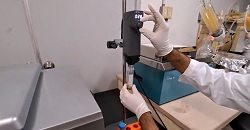Simultaneous detection and quantification of different biogenic amines
Abstract
Biogenic amines are a group of low molecular weight nitrogenous organic compounds that have an important physiological role in cell proliferation, differentiation, and signal transduction. Also, certain biogenic amines act as an important biomarker for the detection of neuroendocrine and cardiovascular disorders in humans. Besides this, the abundance of biogenic amines in food is recognized as a toxin and antinutritional element that have several health implications. This visual experiment demonstrates all the critical steps required for the extraction of biogenic amines followed by derivatization and high performance liquid chromatography analysis for the successive detection and quantification of biogenic amines such as histamine, cadaverine, tryptamine, agmatine, putrescine, 2-phenylethylamine, spermine, tyramine, and spermidine.
References
Linares DM, MartÃn M, Ladero V, Alvarez MA, Fernández M. Biogenic amines in dairy products. Crit Rev Food Sci Nutr. 2011; 51: 691-703.
Plenis A, Olędzka I, Kowalski P, Miękus N, Bączek T. Recent trends in the quantification of biogenic amines in biofluids as biomarkers of various disorders: A review. J Clin Med. 2019; 8: 640.
Sánchezâ€Jiménez F, Ruizâ€Pérez MV, Urdiales JL, Medina MA. Pharmacological potential of biogenic amine–polyamine interactions beyond neurotransmission. Br J Pharmacol. 2013; 170: 4-16.
Naila A, Flint S, Fletcher G, Bremer P, Meerdink G. Control of biogenic amines in food-existing and emerging approaches. J Food Sci. 2010; 75: 139-50.
Food and Drug Administration (US FDA). Fish and fishery products hazards and controls guidance. 4th ed. Center for Food Safety and Applied Nutrition. USA, 2011.
MFDS (The Ministry of Food and Drug Safety). Food code. Notification No. 2017-57; MFDS: Korea, 2017.
CNS (China National Standards). GB 2733-2015 National food safety standards for fresh and frozen animal aquatic products. Beijing, Standards Press of China, 2016.
Płonka J. Food analysis–samples preparation and chromatographic methods in determination of selected biogenic amines, methylxanthines and water-soluble vitamins. Anal Methods. 2012; 4: 3071-94.
Önal A. A review: Current analytical methods for the determination of biogenic amines in foods. Food Chem. 2007; 103: 1475-86.
Jubele A. Chromatographic determination of amines in food samples. 2018.
Munir MA, Badri KH. The importance of derivatizing reagent in chromatography applications for biogenic amine detection in food and beverages. J Anal Methods Chem. 2020; 2: 2020.

